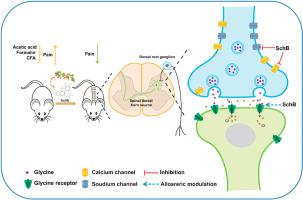当前位置:
X-MOL 学术
›
J. Ethnopharmacol.
›
论文详情
Our official English website, www.x-mol.net, welcomes your
feedback! (Note: you will need to create a separate account there.)
Schisandrin B from Schisandra chinensis alleviated pain via glycine receptors, Nav1.7 channels and Cav2.2 channels
Journal of Ethnopharmacology ( IF 4.8 ) Pub Date : 2024-02-29 , DOI: 10.1016/j.jep.2024.117996
Miao Zhao 1 , Jun Wu 1 , Yuchen Jin 1 , Min Li 1 , KeXin Yu 1 , Haibo Yu 1
Journal of Ethnopharmacology ( IF 4.8 ) Pub Date : 2024-02-29 , DOI: 10.1016/j.jep.2024.117996
Miao Zhao 1 , Jun Wu 1 , Yuchen Jin 1 , Min Li 1 , KeXin Yu 1 , Haibo Yu 1
Affiliation

|
, the dried and ripe fruit of the magnolia family plant (Turcz.) Baill, was commonly used in traditional analgesic prescription. Studies have shown that the extract of (SC) displayed analgesic activity. However, the analgesic active component and the exact mechanisms have yet to be revealed. The present study was to investigate the anti-nociceptive constituent of , assess its analgesic effect, and explore the potential molecular mechanisms. The effects of a series of well-recognized compounds from SC on glycine receptors were investigated. The analgesic effect of the identified compound was evaluated in three pain models. Mechanistic studies were performed using patch clamp technique on various targets expressed in recombinant cells. These targets included glycine receptors, Nav1.7 sodium channels, Cav2.2 calcium channels et al. Meanwhile, primary cultured spinal dorsal horn (SDH) neurons and dorsal root ganglion (DRG) neurons were also utilized. Schisandrin B (SchB) was a positive allosteric modulator of glycine receptors in spinal dorsal horn neurons. The EC of SchB on glycine receptors in spinal dorsal horn neurons was 2.94 ± 0.28 μM. In three pain models, the analgesic effect of SchB was comparable to that of indomethacin at the same dose. Besides, SchB rescued PGE-induced suppression of α3 GlyR activity and alleviated persistent pain. Notably, SchB could also potently decrease the frequency of action potentials and inhibit sodium and calcium channels in DRG neurons. Consistent with the data from DRG neurons, SchB was also found to significantly block Nav1.7 sodium channels and Cav2.2 channels in recombinant cells. Our results demonstrated that, Schisandrin B, the primary lignan component of , may exert its analgesic effect by acting on multiple ion channels, including glycine receptors, Nav1.7 channels, and Cav2.2 channels.
中文翻译:

五味子中的五味子 B 通过甘氨酸受体、Nav1.7 通道和 Cav2.2 通道减轻疼痛
木兰科植物(Turcz.)Baill 的干燥成熟果实,常用于传统镇痛处方中。研究表明(SC)提取物具有镇痛活性。然而,镇痛活性成分和确切机制尚未揭示。本研究旨在探讨 的抗伤害成分,评估其镇痛作用,并探讨其潜在的分子机制。研究了一系列来自 SC 的公认化合物对甘氨酸受体的影响。在三种疼痛模型中评估了所鉴定化合物的镇痛效果。使用膜片钳技术对重组细胞中表达的各种靶标进行机制研究。这些靶标包括甘氨酸受体、Nav1.7 钠通道、Cav2.2 钙通道等。同时,还利用了原代培养的脊髓背角(SDH)神经元和背根神经节(DRG)神经元。五味子素 B (SchB) 是脊髓背角神经元甘氨酸受体的正变构调节剂。 SchB 对脊髓背角神经元甘氨酸受体的 EC 值为 2.94 ± 0.28 μM。在三种疼痛模型中,SchB 的镇痛效果与相同剂量的吲哚美辛相当。此外,SchB 还可以挽救 PGE 诱导的 α3 GlyR 活性抑制并减轻持续性疼痛。值得注意的是,SchB 还可以有效降低动作电位的频率并抑制 DRG 神经元中的钠通道和钙通道。与 DRG 神经元的数据一致,SchB 还被发现能显着阻断重组细胞中的 Nav1.7 钠通道和 Cav2.2 通道。 我们的研究结果表明,五味子乙素是五味子的主要木脂素成分,可能通过作用于多个离子通道(包括甘氨酸受体、Nav1.7通道和Cav2.2通道)发挥镇痛作用。
更新日期:2024-02-29
中文翻译:

五味子中的五味子 B 通过甘氨酸受体、Nav1.7 通道和 Cav2.2 通道减轻疼痛
木兰科植物(Turcz.)Baill 的干燥成熟果实,常用于传统镇痛处方中。研究表明(SC)提取物具有镇痛活性。然而,镇痛活性成分和确切机制尚未揭示。本研究旨在探讨 的抗伤害成分,评估其镇痛作用,并探讨其潜在的分子机制。研究了一系列来自 SC 的公认化合物对甘氨酸受体的影响。在三种疼痛模型中评估了所鉴定化合物的镇痛效果。使用膜片钳技术对重组细胞中表达的各种靶标进行机制研究。这些靶标包括甘氨酸受体、Nav1.7 钠通道、Cav2.2 钙通道等。同时,还利用了原代培养的脊髓背角(SDH)神经元和背根神经节(DRG)神经元。五味子素 B (SchB) 是脊髓背角神经元甘氨酸受体的正变构调节剂。 SchB 对脊髓背角神经元甘氨酸受体的 EC 值为 2.94 ± 0.28 μM。在三种疼痛模型中,SchB 的镇痛效果与相同剂量的吲哚美辛相当。此外,SchB 还可以挽救 PGE 诱导的 α3 GlyR 活性抑制并减轻持续性疼痛。值得注意的是,SchB 还可以有效降低动作电位的频率并抑制 DRG 神经元中的钠通道和钙通道。与 DRG 神经元的数据一致,SchB 还被发现能显着阻断重组细胞中的 Nav1.7 钠通道和 Cav2.2 通道。 我们的研究结果表明,五味子乙素是五味子的主要木脂素成分,可能通过作用于多个离子通道(包括甘氨酸受体、Nav1.7通道和Cav2.2通道)发挥镇痛作用。































 京公网安备 11010802027423号
京公网安备 11010802027423号